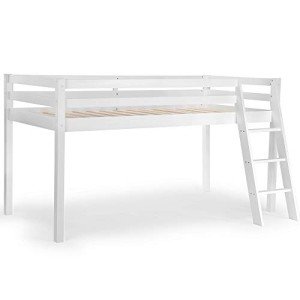10 Undeniable Reasons People Hate Cabin Bed Ladder

Cabin Bed Ladder
Designed to withstand heavy use, this cabin bed ladder is built out of solid Southern Yellow Pine. Like telephone poles material is extremely sturdy and sturdy.
The bed ladder is clipped to the frame, and you are able to hold the other end, the "ladder" end, by the rungs. You can place the ladder at the foot or side of your bed.
Safety Features
A cabin bed ladder should be durable and sturdy to ensure safety. It should be firmly connected to the bed, with no gaps, or looseness that could cause children to climb off their beds or fall off the ladder. Many manufacturers offer professional installation services to guarantee a safe and secure bunk or loft bed. It is essential to carefully review all instructions and safety guidelines prior to attempting DIY.
The ladder should also be properly angled. Ladders that have a slight slope make it easier for younger children to reach the top bunk and are safer for them to climb than conventional vertical ladders. This kind of ladder takes up some more floor space than a standard ladder for bunk beds but it's worth the extra space to lower the risk of accidents.
In addition to ensuring the ladder is secured to the ground, it should also be rounded and have smooth surfaces to prevent injuries from bumps or falls. Round corners also prevent sharp edges that could snag clothing. The frames of ladders and steps should be cleaned to remove rough materials and to eliminate hazards such as splinters. Some models have storage drawers that are built into the steps, which can be useful without compromising safety.
A loft or bunk bed ladder should have guard rails that are at least 5 inches higher than the mattress surface to protect sleepers from accidental falls in the course of play or sleep. Some models have removable railings that permit flexibility and adaptability, whereas others provide permanent installations for long-term stability.
A removable Ladder Gate will prevent your children from climbing to the upper level of the ladder during the night if they are sleepwalkers or dreamers. If you have younger siblings who live together, a Ladder Protection can prevent curious little ones from climbing up to the upper level and causing injury.
Before you purchase a bed that has a ladder, you should measure the dimensions of your child's room to ensure that there is enough space for the bed and any other features that might be connected to it. Check the ceiling height as well, especially when a high-sleeper model is on your list. A bunk or loft bed that is too close to the ceiling could block airflow and cause discomfort. It also poses a fire risk and may obstruct windows, which can cause injury due to broken glass or falling objects.
Length
To ensure safety, you want to ensure that the ladder is the correct length for the space you have. You don't need it too high or too low. For children, the rungs should be 10 inches apart. For adults they should be 12 inches apart.
The rungs should be rounded towards the ends. A square edge could cause splinters and can be rough to touch. This is especially important if you're building your own bunk-bed ladder. It's easy to overlook.
Another thing to think about is where you want the ladder to be attached to the bed frame. cabin beds for small rooms Bunk Beds Store can attach the ladder to the side or foot of the mattress. Both positions offer advantages and disadvantages. It is up to you to choose which is ideal for your bedroom.
Design

A cabin bed ladder is attached to the frame at one end, which is different from traditional ladders that are attached either to the frame or at the foot of the mattress. The user holds the other end by utilizing the rungs. This design gives the user more freedom in bed. This is particularly beneficial for those recovering from abdominal surgery or who have limited mobility. The fact that a cabin bed ladder is only attached at one end makes it simple to install and use. This is crucial, particularly in bunk beds for campers where space could be a challenge.
